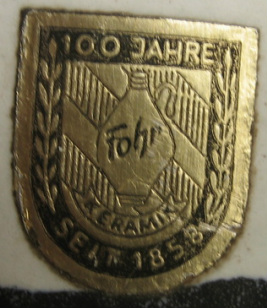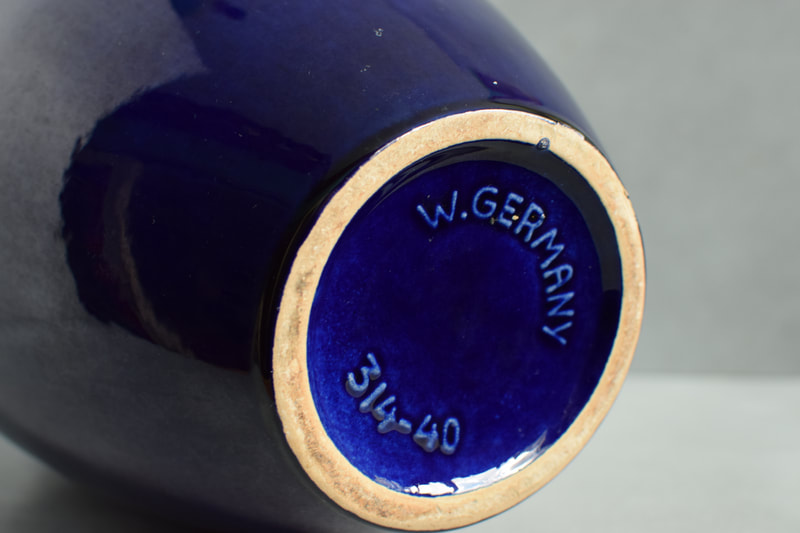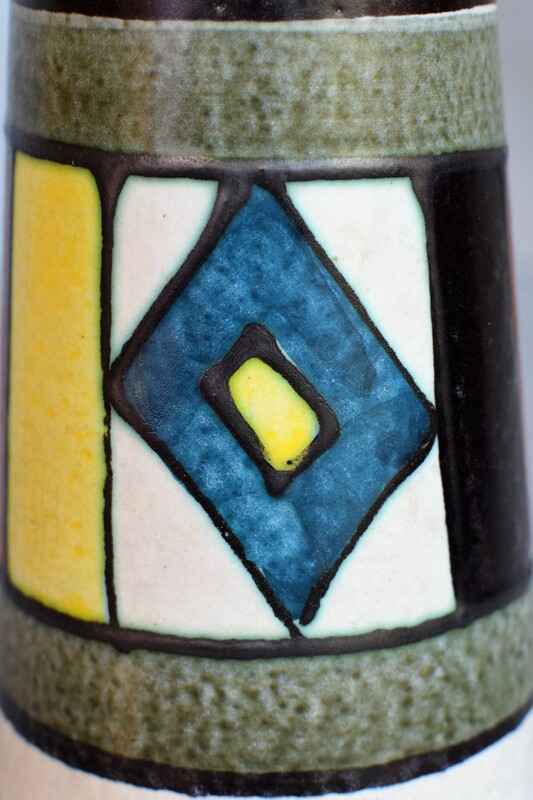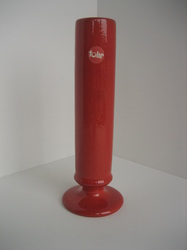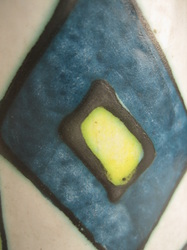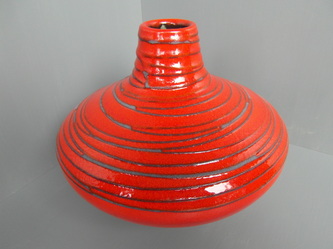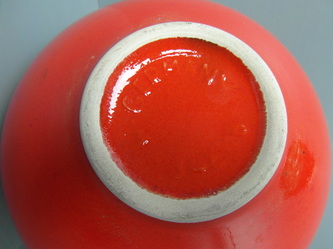Inhoud van deze pagina: Contents of this page:
|
-Inleiding/geschiedenis van Fohr
-Uitleg over tekst aan de onderzijde van Fohr vazen -Labels van Fohr -Foto's van vazen |
-Introduction/history of Fohr
-Explanation about the text at the bottom of Fohr vases -Labels from Fohr -Photographs of vases |
Fohr Keramik.
Gevestigd in Ransbach-Baumbach. De fabriek werd opgericht in 1859 door Peter Fohr. Het assortiment bestond uit aardewerken kruiken, verdampers en bloempotten. In 1934 werd de produktie uitgebreid met sierkeramiek. In 1945 werd het bedrijf onder de broers Alfred en Wilhelm Fohr verdeeld.
Het aanvankelijk overzichtelijke assortiment sierkeramiek werd onder Wilhelm vanaf de jaren-50 geleidelijk uitgebreid.
Als ontwerper van vormen en dekoren was Walter Grau vanaf 1956 werkzaam bij Fohr. Walter Grau kwam uit de porceleinindustrie en had een opleiding voltooid voor modelleur bij de 'Blankenhainer Porzellanfabrik
C. & E. Carstens'. Hij stapte in 1962 over naar de AB Rörstrands Porslinfabrik in Lidköping (Zweden). Zijn opvolger voor ongeveer twee jaar werd Walter Weiland, die in 1960 al enkele maanden op de ontwerpafdeling werkzaam was. Walter Weiland was voorheen bij Ruscha, Keto-Keramik en Marei-Keramik werkzaam als hoofd van de kunstkeramische afdeling.
Vanaf de jaren 60 nam de produktie van sierkeramiek af en de onderneming richtte zich meer op de vervaardiging van sierplantenpotten en bloemschikschalen. De export naar het buitenland nam toe. In 1979 werd een nieuwe fabriek opgericht en in 1984 werd ter gelegenheid van het 125-ste firmajubileum een feestbundel uitgegeven (Baaden, Franz: 125 Jahre Fohr-Keramik 1859-1984, Ransbach-Baumbach 1984).
Fohr Keramik is een familiebedrijf en één van de weinige keramiekbedrijven dat erin geslaagd is om zo'n lange tijd in de running te zijn. Het staat nu onder leiding van Christopher Fohr. Hij is een lid van de vijfde generatie van de familie Fohr die het bedrijf leidt.
Enkele decoren die door Fohr zijn vervaardigd: Patina (1955), Luna (1956), Libello, Grazia (59).
Het aanvankelijk overzichtelijke assortiment sierkeramiek werd onder Wilhelm vanaf de jaren-50 geleidelijk uitgebreid.
Als ontwerper van vormen en dekoren was Walter Grau vanaf 1956 werkzaam bij Fohr. Walter Grau kwam uit de porceleinindustrie en had een opleiding voltooid voor modelleur bij de 'Blankenhainer Porzellanfabrik
C. & E. Carstens'. Hij stapte in 1962 over naar de AB Rörstrands Porslinfabrik in Lidköping (Zweden). Zijn opvolger voor ongeveer twee jaar werd Walter Weiland, die in 1960 al enkele maanden op de ontwerpafdeling werkzaam was. Walter Weiland was voorheen bij Ruscha, Keto-Keramik en Marei-Keramik werkzaam als hoofd van de kunstkeramische afdeling.
Vanaf de jaren 60 nam de produktie van sierkeramiek af en de onderneming richtte zich meer op de vervaardiging van sierplantenpotten en bloemschikschalen. De export naar het buitenland nam toe. In 1979 werd een nieuwe fabriek opgericht en in 1984 werd ter gelegenheid van het 125-ste firmajubileum een feestbundel uitgegeven (Baaden, Franz: 125 Jahre Fohr-Keramik 1859-1984, Ransbach-Baumbach 1984).
Fohr Keramik is een familiebedrijf en één van de weinige keramiekbedrijven dat erin geslaagd is om zo'n lange tijd in de running te zijn. Het staat nu onder leiding van Christopher Fohr. Hij is een lid van de vijfde generatie van de familie Fohr die het bedrijf leidt.
Enkele decoren die door Fohr zijn vervaardigd: Patina (1955), Luna (1956), Libello, Grazia (59).
Fohr Keramik.
Established in Ransbach-Baumbach. The factory was founded in 1859 by Peter Fohr. The production line consisted of earthenware pitchers, vaporizers, and flower pots. In 1934 production was extended with decoration ceramics. In 1945 the concern was divided between the brothers Alfred and Wilhem Fohr.
At the outset the production line was well-ordered,but under the supervision of Wilhelm it was gradually extended during the 50s.
Employed as a designer of shapes and decorations at Fohr since 1956, Walter Grau had his roots in the porcelain industry. He had accomplished his education as a modeller at Blankenhainer Porzellanfabrik named C. & E. Carstens. In 1962 he switched to
AB Rörstrands Porslinfabrik at Lidköping (Sweden). His successor for a period of about two years was to be Walter Weiland, who had worked at the design department forsome months in 1960. Before that time Walter Weiland had been working at Ruscha, Keto Keramik and Marei Keramik, in charge of the department of ceramic art.
Starting from the 60s the production of decoration ceramics decreased. The concern was mainly directed to the manufacture of flower pots for decorative plants and dishes for flower arrangements. Export to countries abroad increased. In 1979 a new branch was founded and it was in 1984 that a festive volume was published at the occasion of the 125th jubilee of the concern (Baaden, Franz: 125 Jahre Fohr Keramik 1859-1984, Ransbach-Baumbach 1984).
Fohr Keramik is a family concern and one of the few ceramic concerns that has succeeded to be in business for such a long time. Christopher Fohr is in charge of it now. He is part of the fifth generation to be in charge of the Fohr family concern.
Some decorations that have been manufactured by Fohr: Patina (1955), Luna (1956), Libello and Grazia (1959).
At the outset the production line was well-ordered,but under the supervision of Wilhelm it was gradually extended during the 50s.
Employed as a designer of shapes and decorations at Fohr since 1956, Walter Grau had his roots in the porcelain industry. He had accomplished his education as a modeller at Blankenhainer Porzellanfabrik named C. & E. Carstens. In 1962 he switched to
AB Rörstrands Porslinfabrik at Lidköping (Sweden). His successor for a period of about two years was to be Walter Weiland, who had worked at the design department forsome months in 1960. Before that time Walter Weiland had been working at Ruscha, Keto Keramik and Marei Keramik, in charge of the department of ceramic art.
Starting from the 60s the production of decoration ceramics decreased. The concern was mainly directed to the manufacture of flower pots for decorative plants and dishes for flower arrangements. Export to countries abroad increased. In 1979 a new branch was founded and it was in 1984 that a festive volume was published at the occasion of the 125th jubilee of the concern (Baaden, Franz: 125 Jahre Fohr Keramik 1859-1984, Ransbach-Baumbach 1984).
Fohr Keramik is a family concern and one of the few ceramic concerns that has succeeded to be in business for such a long time. Christopher Fohr is in charge of it now. He is part of the fifth generation to be in charge of the Fohr family concern.
Some decorations that have been manufactured by Fohr: Patina (1955), Luna (1956), Libello and Grazia (1959).
Labels van Fohr.
Fohr veranderde het originele merk van 'Made in Germany' in 'W. Germany' in het eind 60-er/ begin 70-er jaren.
Fohr changed the original brand from 'Made is Germany' into 'W.Germany' at the end of the 60s/ beginning of the 70s.
Vaas met vorm nr. 314-40 / vase with form nr. 314-40.
Vaas met vorm nr. 330-16 / vase with form nr. 330-16.
Vaas met vorm nr. 414-20 (boven) en vaas met vorm nr. 313-20 (onder).
Vase with form nr. 414-20 (above) and vase with form nr. 313-20 (below).
Vaas met vorm nr. 313-25 / vase with form nr. 313-25.
Vaas met vorm nr. 353-18 / vase with form nr. 353-18.
Vaas met vorm nr. 323-26 / vase with form nr. 323-26.
Vaas met vorm nr. 337-24 / vase with form nr. 337-24.
Enkele details / some details.
Vaas met vorm nr. 346/18 / vase with form nr. 346-18.
Typisch voor vazen van Fohr is dat de aanduiding 'W. GERMANY' , gezien zoals je de bodem leest, bovenaan staat.
Typically for Fohr’s vases is the indication ‘W.Germany’ seen at the top when you read the bottom text.
Typically for Fohr’s vases is the indication ‘W.Germany’ seen at the top when you read the bottom text.



